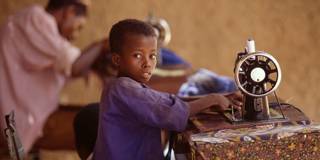According to the OECD, 28-43% of the child labor that is estimated to contribute to exports does so indirectly, through preceding links in supply chains (such as extraction of raw materials or agriculture). But with a holistic approach that engages governments, corporations, and civil society, the practice can be ended – and quickly.
NEW DELHI – Every day, 152 million children perform hard labor, often in hazardous conditions. Bangladesh’s garment factories, which are staffed largely by women and, often, children, are a prime example. Between 2006 and 2012, more than 500 Bangladeshi garment workers died in factory fires. In November 2012, a single fire left 117 workers dead, and more than 200 injured. A mere five months later, a factory outside Dhaka collapsed, killing more than 1,100 people and injuring over 2,500 more.

NEW DELHI – Every day, 152 million children perform hard labor, often in hazardous conditions. Bangladesh’s garment factories, which are staffed largely by women and, often, children, are a prime example. Between 2006 and 2012, more than 500 Bangladeshi garment workers died in factory fires. In November 2012, a single fire left 117 workers dead, and more than 200 injured. A mere five months later, a factory outside Dhaka collapsed, killing more than 1,100 people and injuring over 2,500 more.